<Back to Index>
- Physicist and Engineer Benoît Paul Émile Clapeyron, 1799
- Physicist and Physician Hermann Ludwig Ferdinand von Helmholtz, 1821
- Physicist Peter Guthrie Tait, 1831
PAGE SPONSOR
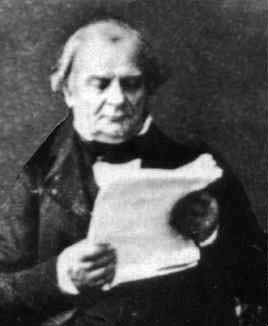
Benoît Paul Émile Clapeyron (26 February 1799 – 28 January 1864) was a French engineer and physicist, one of the founders of thermodynamics.
Born in Paris, Clapeyron studied at the École polytechnique and the École des mines, before leaving for Saint Petersburg in 1820 to teach at the École des Travaux Publics. He returned to Paris only after the Revolution of July 1830, supervising the construction of the first railway line connecting Paris to Versailles and Saint - Germain. He married Mélanie Bazaine, daughter of Pierre - Dominique Bazaine (mathematician and ingénieur des ponts), and older sister of Pierre - Dominique (Adolphe) Bazaine (railway engineer) and Francois Achille Bazaine (Marshal of France).
In 1834, he made his first contribution to the creation of modern thermodynamics by publishing a report entitled the Driving force of the heat (Puissance motrice de la chaleur), in which it developed the work of the physicist Nicolas Léonard Sadi Carnot, deceased two years before. Though Carnot had developed a compelling analysis of a generalized heat engine, he had employed the clumsy and already unfashionable caloric theory.
Clapeyron, in his memoire, presented Carnot's work in a more accessible and analytic graphical form, showing the Carnot cycle as a closed curve on an indicator diagram, a chart of pressure against volume (named in his honor Clapeyron's graph).
In 1843, Clapeyron further developed the idea of a reversible process, already suggested by Carnot and made a definitive statement of Carnot's principle, what is now known as the second law of thermodynamics.
These foundations enabled him to make substantive extensions of Clausius' work, including the formula, now known as the Clausius – Clapeyron relation, which characterizes the phase transition between two phases of matter. He further considered questions of phase transitions in what later became known as Stefan problems.
Clapeyron also worked on the characterization of perfect gases, the equilibrium of homogeneous solids, and calculations of the statics of continuous beams, notably the theorem of three moments (Clapeyron's theorem).
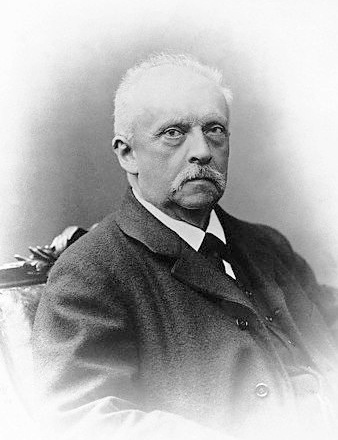
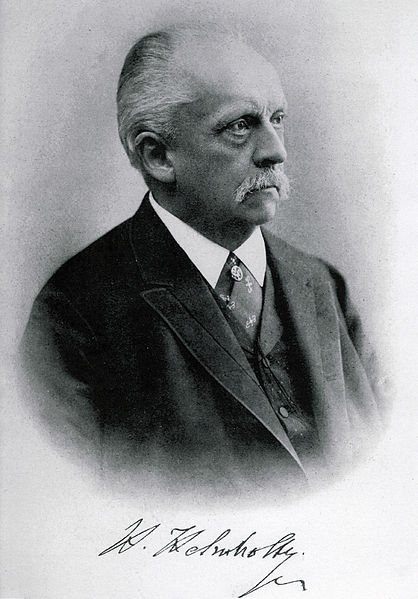
Hermann Ludwig Ferdinand von Helmholtz (August 31, 1821 – September 8, 1894) was a German physician and physicist who made significant contributions to several widely varied areas of modern science. In physiology and psychology, he is known for his mathematics of the eye, theories of vision, ideas on the visual perception of space, color vision research, and on the sensation of tone, perception of sound and empiricism. In physics, he is known for his theories on the conservation of energy, work in electrodynamics, chemical thermodynamics, and on a mechanical foundation of thermodynamics. As a philosopher, he is known for his philosophy of science, ideas on the relation between the laws of perception and the laws of nature, the science of aesthetics, and ideas on the civilizing power of science. The largest German association of research institutions, the Helmholtz Association, is named after him.
Helmholtz was the son of the Potsdam Gymnasium headmaster, Ferdinand Helmholtz, who had studied classical philology and philosophy, and who was a close friend of the publisher and philosopher Immanuel Hermann Fichte. Helmholtz's work is influenced by the philosophy of Fichte and Kant. He tried to trace their theories in empirical matters like physiology.
As a young man, Helmholtz was interested in natural science, but his father wanted him to study medicine at the Charité because there was financial support for medical students.
Trained primarily in physiology, Helmholtz wrote on many other topics, ranging from theoretical physics, to the age of the Earth, to the origin of the solar system.
Helmholtz's first academic position was associate professor of physiology at the Prussian University of Königsberg, where he was appointed in 1849. In 1855 he accepted a full professorship of anatomy and physiology at the University of Bonn. He was not particularly happy in Bonn, however, and three years later he transferred to the University of Heidelberg, in Baden, where he served as professor of physiology. In 1871 he accepted his final university position, as professor of physics at the University of Berlin.
His first important scientific achievement, an 1847 physics treatise on the conservation of energy was written in the context of his medical studies and philosophical background. He discovered the principle of conservation of energy while studying muscle metabolism. He tried to demonstrate that no energy is lost in muscle movement, motivated by the implication that there were no vital forces necessary to move a muscle. This was a rejection of the speculative tradition of Naturphilosophie which was at that time a dominant philosophical paradigm in German physiology.
Drawing on the earlier work of Sadi Carnot, Émile Clapeyron and James Prescott Joule, he postulated a relationship between mechanics, heat, light, electricity and magnetism by treating them all as manifestations of a single force (energy in modern terms). He published his theories in his book Über die Erhaltung der Kraft (On the Conservation of Force, 1847). Whether or not Helmholtz knew of Julius Robert von Mayer's discovery of the law of conservation of energy in the beginning of the 1840s is a point of controversy. Helmholtz did not quote Mayer in his work and was accused by contemporaries of plagiarism.
In the 1850s and 60s, building on the publications of William Thomson, Helmholtz and William Rankine popularized the idea of the heat death of the universe.
In fluid dynamics, Helmholtz made several contributions, including Helmholtz's theorems for vortex dynamics in inviscid fluids.
The sensory physiology of Helmholtz was the basis of the work of Wilhelm Wundt, a student of Helmholtz, who is considered one of the founders of experimental psychology. He, more explicitly than Helmholtz, described his research as a form of empirical philosophy and as a study of the mind as something separate. Helmholtz had, in his early repudiation of Naturphilosophie, stressed the importance of materialism, and was focusing more on the unity of "mind" and body.
In 1851, Helmholtz revolutionized the field of ophthalmology with the invention of the ophthalmoscope; an instrument used to examine the inside of the human eye. This made him world famous overnight. Helmholtz's interests at that time were increasingly focused on the physiology of the senses. His main publication, entitled Handbuch der Physiologischen Optik (Handbook of Physiological Optics or Treatise on Physiological Optics), provided empirical theories on depth perception, color vision and motion perception, and became the fundamental reference work in his field during the second half of the nineteenth century. It was first translated into English under the editorship of James P.C. Southall on behalf of the Optical Society of America in 1924-5. His theory of accommodation went unchallenged until the final decade of the 20th century.
Helmholtz continued to work for several decades on several editions of the handbook, frequently updating his work because of his dispute with Ewald Hering who held opposite views on spatial and color vision. This dispute divided the discipline of physiology during the second half of the 1800s.
In 1849, while at Königsberg, Helmholtz measured the speed at which the signal is carried along a nerve fiber. At that time most people believed that nerve signals passed along nerves immeasurably fast. He used a recently dissected sciatic nerve of a frog and the calf muscle to which it attached. He used a galvanometer as a sensitive timing device, attaching a mirror to the needle to reflect a light beam across the room to a scale which gave much greater sensitivity. Helmholtz reported transmissions speeds in the range of 24.6 - 38.4 meters per second.
In 1863 Helmholtz published Die Lehre von den Tonempfindungen als physiologische Grundlage für die Theorie der Musik (On the Sensations of Tone as a Physiological Basis for the Theory of Music), once again demonstrating his interest in the physics of perception. This book influenced musicologists into the twentieth century. Helmholtz invented the Helmholtz resonator to identify the various frequencies or pitches of the pure sine wave components of complex sounds containing multiple tones.
Helmholtz showed that different combinations of resonator could mimic vowel sounds: Alexander Graham Bell in particular was interested in this but, due to not being able to read German, misconstrued Helmholtz' diagrams as meaning that Helmholtz had transmitted multiple frequencies by wire - which would allow multiplexing of telegraph signals - whereas, in reality, electrical power was only used to keep the resonators in motion. Bell failed to reproduce what he thought Helmholtz had done but later said that, had he been able to read German, he would not have gone on to invent the telephone on the harmonic telegraph principle.
The translation by Alexander J. Ellis was first published in 1875 (the first English edition was from the 1870 third German edition; Ellis's second English edition from the 1877 fourth German edition was published in 1885; the 1895 and 1912 third and fourth English editions were reprints of the second).
Helmholtz studied the phenomena of electrical oscillations from 1869 to 1871, and in a lecture delivered to the Nat. Hist. Med. Ver. at Heidelberg on April 30, 1869 titled On Electrical Oscillations he indicated that the perceptible damped electrical oscillations in a coil joined up with a Leyden jar were about 1/50th of a second in duration. In 1871 he announced that the velocity of the propagation of electromagnetic induction was about 314,000 meters per second.
In 1871 Helmholtz moved from Heidelberg to Berlin to become a professor in physics. He became interested in electromagnetism and the Helmholtz equation is named for him. Although he did not make major contributions to this field, his student Heinrich Rudolf Hertz became famous as the first to demonstrate electromagnetic radiation. Oliver Heaviside criticized Helmholtz's electromagnetic theory because it allowed the existence of longitudinal waves. Based on work on Maxwell's equations, Heaviside pronounced that longitudinal waves could not exist in a vacuum or a homogeneous medium. Heaviside did not note, however, that longitudinal electromagnetic waves can exist at a boundary or in an enclosed space.
Whoever in the pursuit of science, seeks after immediate practical utility may rest assured that he seeks in vain. --Academic Discourse (Heidelberg 1862)
Other students and research associates of Helmholtz at Berlin included Max Planck, Heinrich Kayser, Eugen Goldstein, Wilhelm Wien, Arthur König, Henry Augustus Rowland, A.A. Michelson, Wilhelm Wundt, Fernando Sanford and Michael I. Pupin. Leo Koenigsberger, who studied at Berlin while Helmholtz was there, wrote the definitive biography of him in 1902.
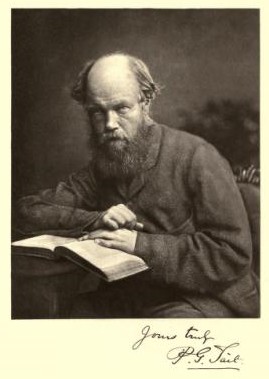
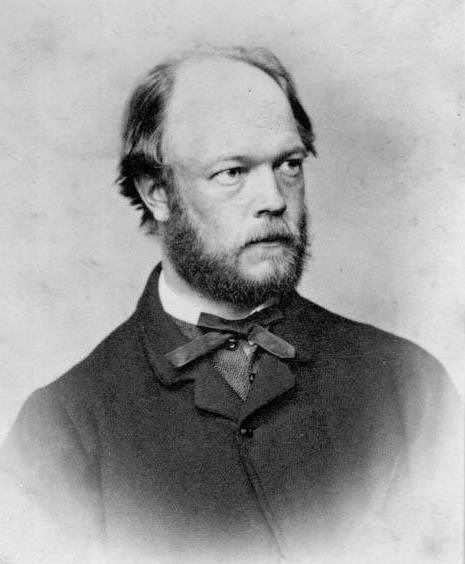
Peter Guthrie Tait FRSE (28 April 1831 – 4 July 1901) was a Scottish mathematical physicist, best known for the seminal energy physics textbook Treatise on Natural Philosophy, which he co-wrote with Kelvin, and his early investigations into knot theory, which contributed to the eventual formation of topology as a mathematical discipline. His name is known in graph theory mainly for Tait's conjecture.
He was born in Dalkeith. After attending the Edinburgh Academy and University of Edinburgh, he went up to Peterhouse, Cambridge, graduating as senior wrangler and first Smith's prizeman in 1852. As a fellow and lecturer of his college he remained in Cambridge for two years longer, and then left to take up the professorship of mathematics at Queen's College, Belfast. There he made the acquaintance of Thomas Andrews, whom he joined in researches on the density of ozone and the action of the electric discharge on oxygen and other gases, and by whom he was introduced to Sir William Rowan Hamilton and quaternions.
In 1860, Tait succeeded his old master, JD Forbes, as professor of natural philosophy at Edinburgh, and occupied that chair until shortly before his death. The first scientific paper under Tait's name only was published in 1860. His earliest work dealt mainly with mathematical subjects, and especially with quaternions, which he was the leading exponent of after their originator, Hamilton. He was the author of two textbooks on them — one an Elementary Treatise on Quaternions (1867), written with the advice of Hamilton, though not published till after his death, and the other an Introduction to Quaternions (1873), in which he was aided by Philip Kelland (1808 – 1879), one of his teachers at Edinburgh. Quaternions was also one of the themes of his address as president of the mathematical section of the British Association for the Advancement of Science in 1871.
He also produced original work in mathematical and experimental physics. In 1864, he published a short paper on thermodynamics, and from that time his contributions to that and kindred departments of science became frequent and important. In 1871, he emphasized the significance and future importance of the principle of the dissipation of energy (second law of thermodynamics). In 1873 he took thermoelectricity for the subject of his discourse as Rede lecturer at Cambridge, and in the same year he presented the first sketch of his well known thermoelectric diagram before the Royal Society of Edinburgh.
Two years later, researches on "Charcoal Vacua" with James Dewar led him to see the true dynamical explanation of the Crookes radiometer in the large mean free path of the molecule of the highly rarefied air. From 1879 to 1888, he engaged in difficult experimental investigations. These began with an inquiry into what corrections were required for thermometers operating at great pressure. This was for the benefit of thermometers employed by the Challenger expedition for observing deep - sea temperatures, and were extended to include the compressibility of water, glass and mercury. This work led to the first formulation of the Tait equation, which is widely used to fit liquid density to pressure. Between 1886 and 1892 he published a series of papers on the foundations of the kinetic theory of gases, the fourth of which contained what was, according to Lord Kelvin, the first proof ever given of the Waterston - Maxwell theorem (equipartition theorem) of the average equal partition of energy in a mixture of two gases. About the same time he carried out investigations into impact and its duration.
Many other inquiries conducted by him might be mentioned, and some idea may be gained of his scientific activity from the fact that a selection only from his papers, published by the Cambridge University Press, fills three large volumes. This mass of work was done in the time he could spare from his professorial teaching in the university. For example in 1880 he worked on the Four color theorem and proved that it was true if and only if no snarks were planar.
In addition, he was the author of a number of books and articles. Of the former, the first, published in 1865, was on the dynamics of a particle; and afterwards there followed a number of concise treatises on thermodynamics, heat, light, properties of matter and dynamics, together with an admirably lucid volume of popular lectures on Recent Advances in Physical Science.
With Lord Kelvin, he collaborated in writing the well known Treatise on Natural Philosophy. "Thomson and Tait," as it is familiarly called ("T and T" was the authors' own formula), was planned soon after Lord Kelvin became acquainted with Tait, on the latter's appointment to his professorship in Edinburgh, and it was intended to be an all comprehensive treatise on physical science, the foundations being laid in kinematics and dynamics, and the structure completed with the properties of matter, heat, light, electricity and magnetism. But the literary partnership ceased in about eighteen years, when only the first portion of the plan had been completed, because each of the members felt he could work to better advantage separately than jointly. The friendship, however, endured for the remaining twenty - three years of Tait's life.
Tait collaborated with Balfour Stewart in the Unseen Universe, which was followed by Paradoxical Philosophy. It was in his 1875 review of The Unseen Universe, that William James first put forth his Will to Believe Doctrine. Tait's articles include those he wrote for the ninth edition of the Encyclopćdia Britannica on Light, Mechanics, Quaternions, Radiation, and Thermodynamics, and the biographical notices of Hamilton and Clerk Maxwell.
Tait was an enthusiastic golfer and, of his seven children, two, Frederick Guthrie Tait (1870 – 1900) and John Guthrie Tait (1861 – 1945) went on to become gifted amateur champions. John was an all round sportsman and represented Scotland at international level in rugby union. Tait himself had, in 1891, invoked the Magnus effect to explain the influence of spin on the flight of a golf ball.